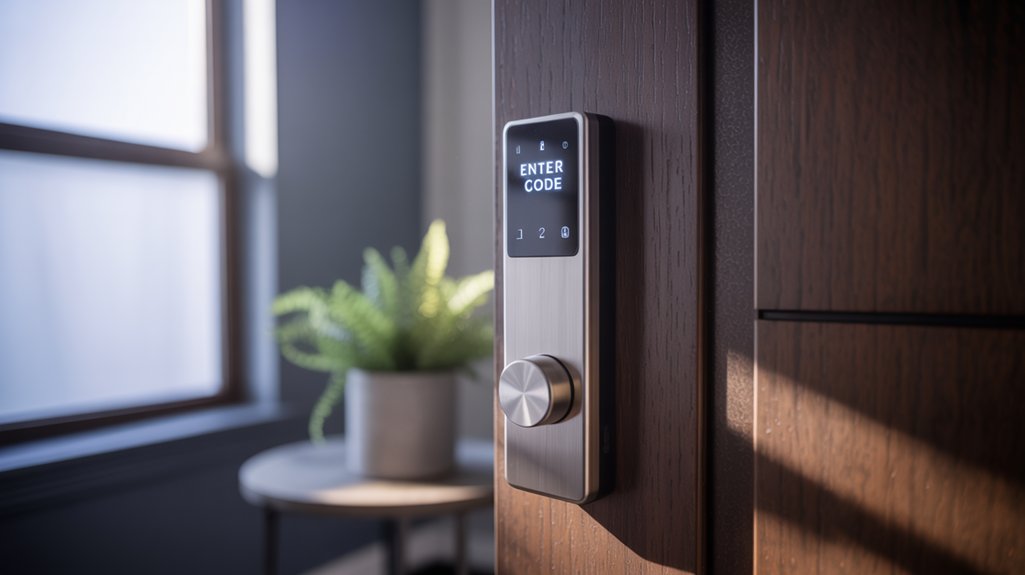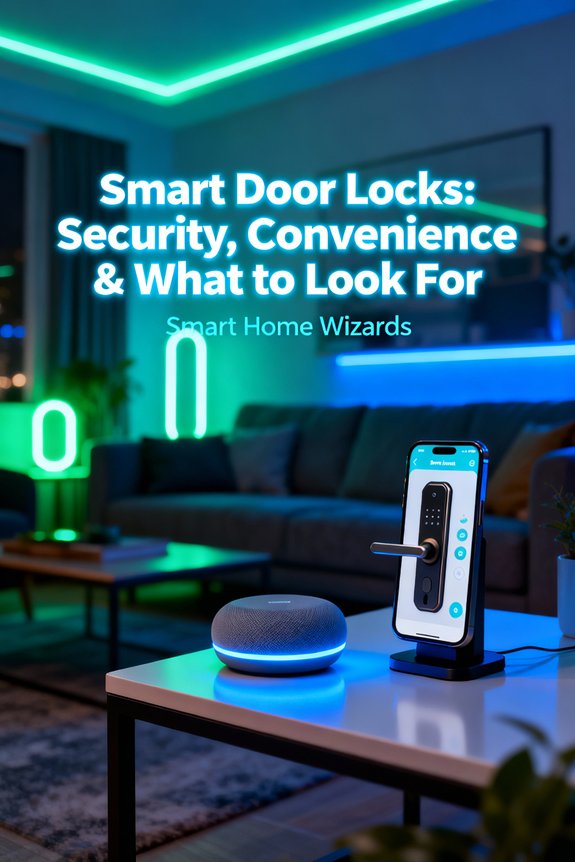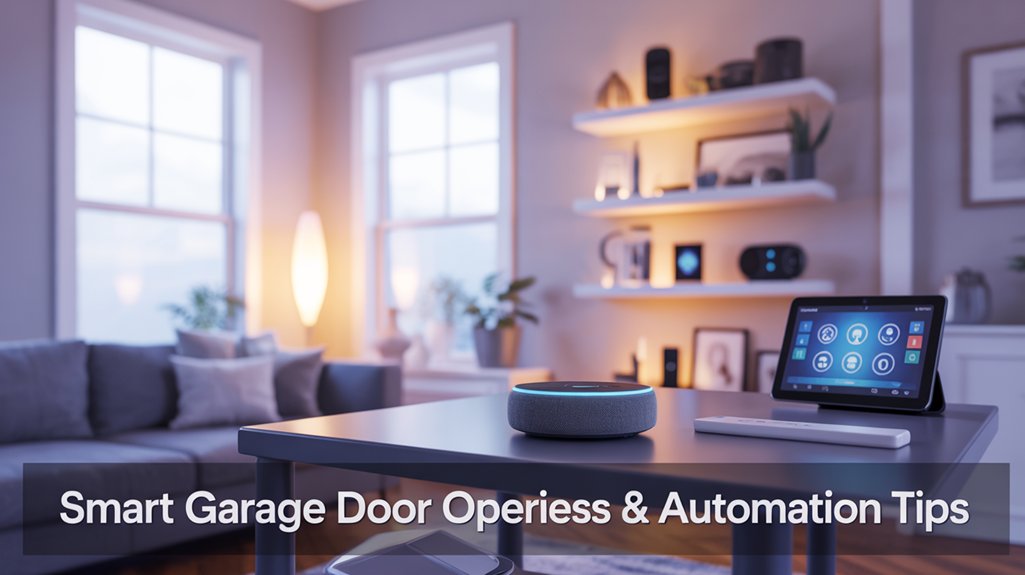Smart door locks replace traditional keys with encrypted wireless authentication, using AES 256-bit encryption and protocols like Z-Wave or Bluetooth. You’ll need to verify your door’s backset (2-3/8″ or 2-3/4″), bore diameter (2-1/8″), and thickness (1-3/8″ to 1-3/4″) before purchasing. Look for ANSI/BHMA Grade 1 certification, multi-factor authentication, and tamper alerts to mitigate electronic vulnerabilities. Battery backup systems prevent lockouts during power failures. Understanding these technical specifications and security standards will help you navigate the tradeoffs between convenience and risk exposure.
Key Takeaways
- Smart locks use AES encryption and multi-factor authentication to secure access while offering Bluetooth, Wi-Fi, Z-Wave, or Zigbee connectivity options.
- Essential security features include tamper alerts, auto-lockout, battery backup systems, and ANSI/BHMA Grade 1 or 2 compliance standards.
- Access methods combine keypads, fingerprint scanners, smartphone apps, and physical keys for flexible control with emergency failsafe options.
- Pre-purchase verification requires measuring door thickness, backset distance, and bore hole diameter to ensure proper installation compatibility.
- Integration depends on selecting connectivity protocols that align with existing smart home ecosystems like Apple HomeKit, Alexa, or Google Home.
How Smart Door Locks Work: The Technology Behind Keyless Entry
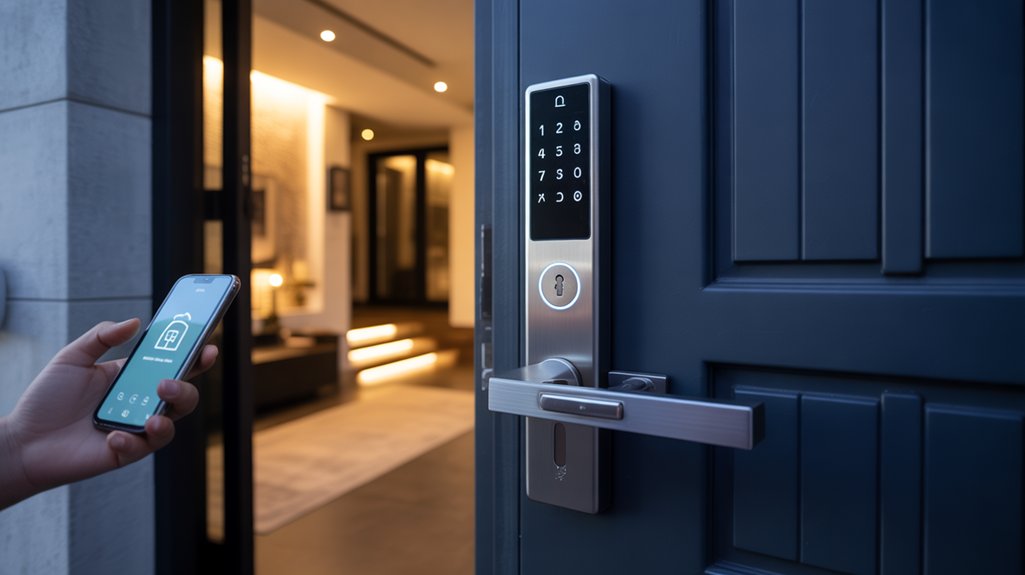
Smart door locks replace traditional mechanical pin-tumbler mechanisms with electronic authentication systems that validate credentials through wireless protocols, biometric sensors, or numeric keypads.
You’ll find these systems utilize AES 128-bit or 256-bit encryption standards to protect communication between your smartphone and the lock’s microcontroller.
The authentication process executes through multiple pathways: Bluetooth Low Energy (BLE) for proximity-based entry, Z-Wave or Zigbee protocols for smart home integration, and Wi-Fi modules enabling remote access from any location.
Biometric technology employs capacitive fingerprint scanning with false acceptance rates below 0.001%, ensuring authorized entry while rejecting impostor attempts.
Your lock’s firmware processes authentication requests within milliseconds, activating the motorized bolt mechanism only after credential verification.
Battery-powered systems typically operate 8-12 months on standard AA batteries, with low-power alerts transmitted directly to your device.
Integration with ANSI/BHMA Grade 1 certified deadbolts provides physical security matching electronic protection levels.
Many smart locks now support HomeKit compatibility and Matter protocols, allowing seamless integration with Apple’s ecosystem and other smart home platforms for unified control alongside security cameras and other connected devices.
Essential Security Features: Encryption, Authentication, and Anti-Tampering Protections
While electronic convenience defines the user experience, your smart lock’s security architecture determines whether it protects or exposes your home to unauthorized access.
You’ll need AES 128-bit or 256-bit encryption standards protecting data transmission between your lock, smartphone, and cloud servers. Weaker protocols create exploitable security vulnerabilities.
Authentication methods establish access control hierarchy. Multi-factor authentication combining PIN codes, biometrics, and proximity credentials provides layered defense against unauthorized entry. Single-factor systems represent critical weak points.
Anti tampering technologies detect and respond to physical attacks. You should demand locks featuring tamper alerts, auto-lockout after failed attempts, and reinforced strike plates resisting forced entry.
Battery backup prevents power-loss exploitation.
Verify compliance with ANSI/BHMA Grade 1 or 2 standards and examine manufacturer vulnerability disclosure policies. Your lock’s firmware update capability addresses emerging threats, but poorly implemented updates introduce new attack vectors.
Review third-party penetration testing results before purchase.
Smart locks integrate seamlessly with broader home security systems, creating comprehensive protection that extends beyond traditional door hardware.
Connectivity Options: Wi-Fi, Bluetooth, Z-Wave, and Zigbee Explained
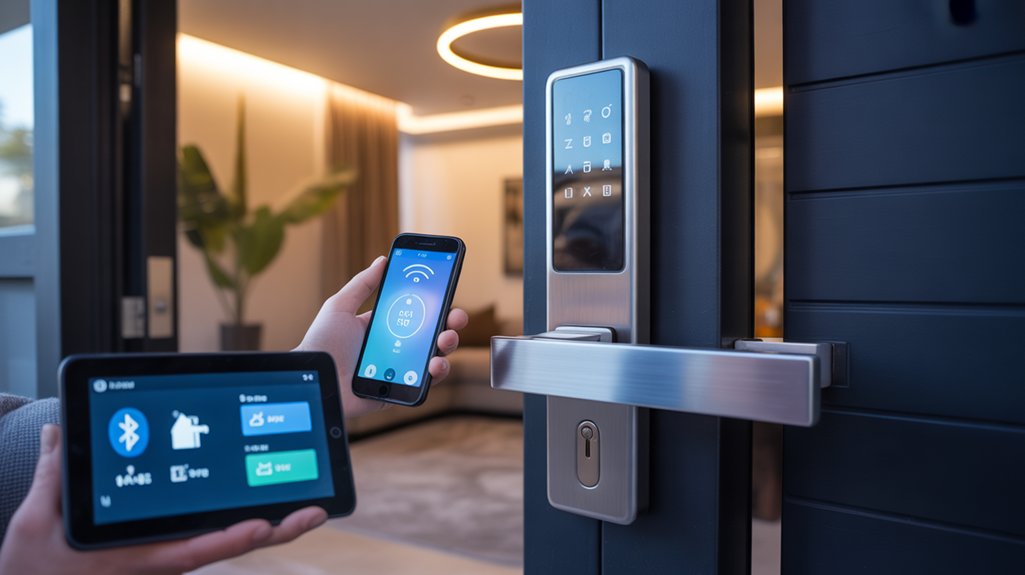
Your lock’s communication protocol determines network reliability, range limitations, power consumption, and smart home ecosystem compatibility. Understanding these wireless standards enables strategic selection aligned with your infrastructure requirements.
Matching your smart lock’s wireless protocol to your existing infrastructure ensures optimal performance, reliability, and seamless ecosystem integration.
Protocol Specifications:
* Wi-Fi – Direct internet connectivity without hubs, enabling remote access anywhere. High power consumption necessitates frequent battery replacements or hardwired installation.
Compatible with most ecosystems but vulnerable to network outages.
- Bluetooth – Proximity-based operation (typically 30-100 feet) with minimal power draw. Requires smartphone presence for access; no remote management without additional bridge hardware.
- Z-Wave – Mesh networking protocol operating on dedicated 908.42 MHz frequency (US). Requires certified hub but offers exceptional device compatibility across 3,000+ products.
Superior interference resistance compared to 2.4 GHz standards.
* Zigbee – Open-source mesh protocol with lower certification costs. Shares crowded 2.4 GHz spectrum with Wi-Fi, potentially causing interference.
Hub-dependent with variable cross-manufacturer compatibility.
Select protocols matching your existing smart home infrastructure and operational requirements.
Smart Home Integration: Compatibility With Alexa, Google Home, and Apple Homekit
Cross-platform operation demands strategic evaluation of your existing smart home ecosystems.
Multi-ecosystem locks sacrifice specialized features for broad compatibility, while platform-specific devices utilize proprietary APIs for improved voice command integration.
Matter-certified locks promise unified interoperability, though adoption remains inconsistent across manufacturers.
Prioritize devices supporting your primary ecosystem’s advanced security protocols rather than settling for basic universal compatibility.
Access Control Methods: Keypads, Fingerprints, Smartphone Apps, and Physical Keys
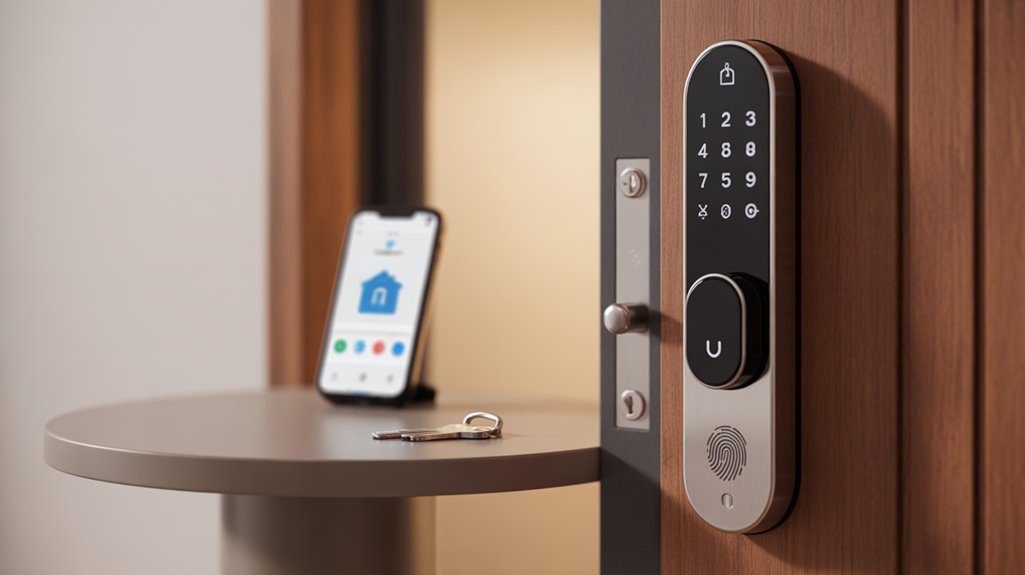
Modern smart locks implement four primary authentication mechanisms, each presenting distinct security trade-offs and failure modes.
Core Access Methods:
- Keypads – Keypad advantages include operation during network failures and no device dependency. However, you’ll face PIN compromise risks through shoulder surfing or wear pattern analysis on frequently-used digits.
- Fingerprint Scanners – Fingerprint accuracy depends on sensor quality and environmental conditions. False rejection rates of 1-3% are standard, while moisture and dirt degrade performance considerably.
- Smartphone Apps – Smartphone convenience enables remote access and audit logging, but you’re vulnerable to device theft, battery depletion, and connectivity interruptions. Bluetooth and Wi-Fi implementations vary in range and reliability.
- Physical Keys – Physical key redundancy provides critical failsafe access during electronic malfunctions or power loss. ANSI/BHMA Grade 1 cylinders resist picking and drilling attacks that bypass electronic systems entirely.
You’ll enhance security by deploying multi-factor authentication combining these methods strategically.
Power Sources and Backup Solutions: Battery Life and Emergency Access
Smart locks typically operate on four AA batteries delivering 6-12 months of operation under normal usage conditions, though cold temperatures below 32°F can reduce capacity by 30-50% and accelerate voltage degradation.
You’ll need to monitor battery levels through your smartphone app’s low-power alerts, typically triggered at 20% remaining capacity. Lithium battery types outperform alkaline alternatives in extreme climates, maintaining 85% efficiency at -40°F versus alkaline’s 50% degradation threshold.
Your backup access strategy requires redundancy layers. Most manufacturers include mechanical emergency keys as failsafe mechanisms, though you’re exposing yourself to traditional lock-picking vulnerabilities.
External 9V battery terminals provide temporary power restoration—delivering 30-50 access cycles when connected to the lock’s exterior contact points. You should maintain physical key access in secure off-site locations and establish backup user codes with trusted parties.
ANSI/BHMA Grade 1 certified locks mandate mechanical override systems, ensuring you’re never completely barred during total power failure scenarios.
Installation Requirements: Compatibility With Your Existing Door Hardware
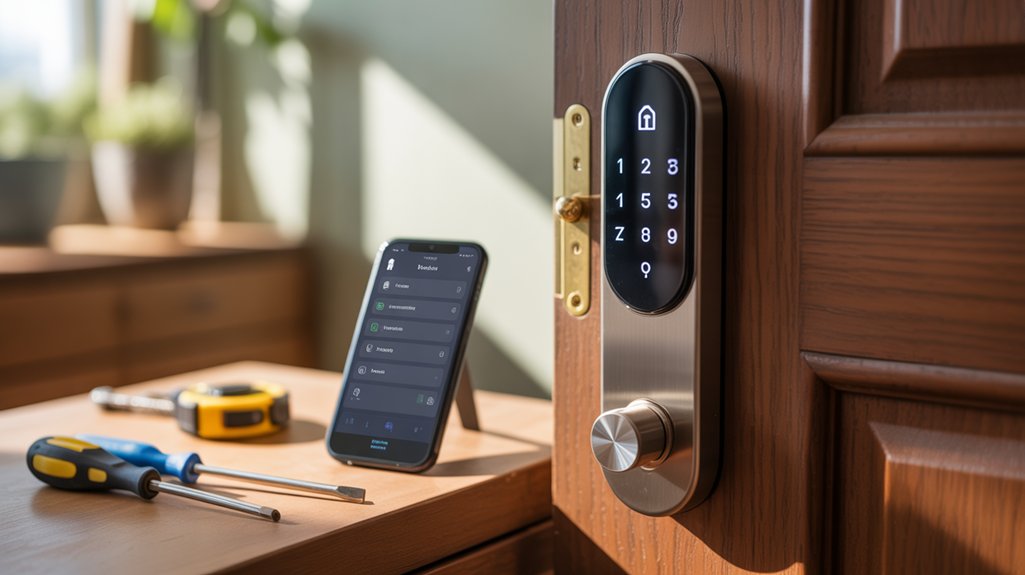
Before purchasing a smart lock, you’ll need to verify your door meets specific dimensional and material requirements to avoid compatibility failures.
Standard residential doors require precise backset measurements (typically 2-3/8″ or 2-3/4″) and bore hole diameters (usually 2-1/8″) that align with ANSI/BHMA standards.
Your door’s thickness (standard range: 1-3/8″ to 1-3/4″) and material composition—whether wood, metal, or composite—directly determine which smart lock models you can safely install without compromising structural integrity or warranty coverage.
Door Thickness and Material
Most smart locks specify compatible door thickness ranges between 1-3/8 inches and 1-3/4 inches—the standard dimensions for residential exterior doors in North America per ANSI/BHMA A156.115 specifications.
You’ll need to verify your door dimensions before purchase to prevent compatibility failures.
Material types directly impact installation success and lock performance:
- Wood doors accept standard mounting hardware without modification.
- Metal doors require self-tapping screws and may need pre-drilling to prevent thread stripping.
- Fiberglass composite doors demand careful torque management to avoid cracking.
- Glass doors typically can’t accommodate smart locks due to structural limitations.
Non-standard door dimensions or hollow-core construction may compromise mounting integrity.
Steel reinforcement plates become critical for doors lacking sufficient structural density to support electronic lock assemblies and resist forced-entry attempts.
Backset and Bore Measurements
Beyond door thickness and material composition, your existing lockset’s dimensional specifications determine whether a smart lock will physically integrate with your current hardware configuration.
Backset—the distance from the door’s edge to the center of the bore hole—comes in two standard measurements: 2-3/8 inches (common in residential applications) and 2-3/4 inches (typical for commercial installations and newer construction).
Bore measurements refer to the hole diameter drilled through your door, standardized at 2-1/8 inches per ANSI/BHMA standards.
Verify these backset measurements and bore measurements before purchasing—incompatible dimensions necessitate door modification or complete hardware replacement.
You’ll find specification sheets list compatible configurations, but physical verification with calipers eliminates costly installation failures.
Non-standard measurements require custom solutions or alternative lock selection, making pre-purchase measurement verification your critical first step.
Frequently Asked Questions
What Happens to My Smart Lock Data if the Company Goes Out of Business?
If your smart lock company fails, you’ll likely lose cloud-based access and remote features immediately. Your data privacy becomes uncertain—credentials may transfer to acquirers or vanish entirely.
Assess company stability before purchase by reviewing their financial backing and industry standing. You’ll retain local functionality if the lock supports offline operation, but firmware updates and security patches cease.
Choose manufacturers adhering to ISO 27001 standards who commit to data deletion protocols and shift plans for business discontinuation.
Can Smart Locks Be Hacked Remotely by Cybercriminals?
Your digital fortress can become a gateway if compromised. Yes, cybercriminals can exploit vulnerabilities in smart locks through remote access, particularly when manufacturers implement weak security protocols.
You’ll find that locks certified under UL 1037 and ANSI/BHMA standards offer superior protection against such attacks.
Encryption strength, two-factor authentication, and regular firmware updates determine your defense perimeter. You’re only as secure as your weakest protocol—choose locks with military-grade encryption and established cybersecurity histories to maintain control.
Will My Homeowner’s Insurance Cover Smart Lock Malfunctions or Break-Ins?
Insurance coverage for smart locks varies considerably by policy and carrier.
You’ll need to review your homeowner’s policy specifics—most standard policies don’t explicitly cover lock malfunction unless it’s vandalism-related.
However, break-in losses typically remain covered regardless of lock type.
Request written confirmation from your insurer about smart lock acceptance.
Some carriers may require UL 437-certified locks or documentation of proper installation.
Don’t assume coverage; verify it protects your investment and liability exposure.
How Do Smart Locks Perform in Extreme Weather Conditions or Temperatures?
Coincidentally, your climate poses the greatest threat to smart lock reliability when you need security most.
You’ll find premium models specify temperature tolerance from -22°F to 140°F (IP65-rated), while budget units fail at 32°F.
Demand weather resistance certifications—ANSI/BHMA Grade 1 guarantees performance under thermal cycling tests.
Your lock’s electronic components degrade faster in humidity and extreme cold, compromising battery life and motor function.
Verify manufacturer specifications match your regional extremes before deployment.
Are Smart Locks Approved by Landlords for Rental Properties?
You’ll need explicit landlord approval before installing smart locks—most rental agreements prohibit unauthorized modifications.
Review your lease’s alteration clause and submit a written request detailing the installation’s reversibility. Cite ANSI/BHMA security standards to strengthen your case.
If you’re denied, negotiate terms like professional installation and returning original hardware upon move-out. Document everything in writing.
Smart locks that don’t require permanent modifications typically face fewer objections, giving you an advantage in negotiations.
Conclusion
You’re standing at the intersection of convenience and vulnerability. Smart locks aren’t just gadgets—they’re your home’s digital sentinels, demanding careful evaluation against ANSI/BHMA standards and UL certifications. Don’t let marketing gloss over encryption protocols or battery failure scenarios. Your security architecture is only as strong as its weakest link. Choose a lock that’s been proven reliable against both physical and cyber threats, because your front door shouldn’t be your network’s Achilles’ heel.

